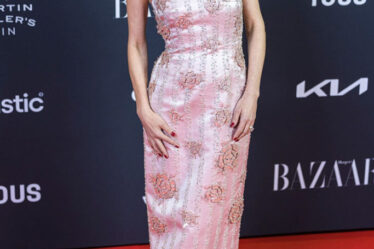
The Sicilian chef Corrado Assenza studied agronomy at the University of Bologna before returning to his home town of Noto and taking over his aunt’s patisserie shop and the land farmed by his grandparents. It turned out to be a productive collision: new knowledge meeting the empirical knowledge of a Sicilian pastry laboratory, and Corrado’s imaginative, wishful thinking. Like many people, we have visited his Caffè Sicilia and eaten almond granita and almond-and-sesame biscuits filled with bitter marmalade, and enjoyed bergamot cream, liquorice and wild fennel tea, as well as a ricotta-filled tube of cannoli decorated with a curl of candied orange.
I also had the chance to watch Corrado cook at a demonstration about citrus and honey at the Anna Tasca Lanza cooking school. He infused cream with bitter orange and mandarin to serve with almond cake; made pasta with anchovy and lemon, and topped it with breadcrumbs; braised artichokes with wild herbs; grilled sausage polpette between lemon leaves. But what I remember most was his rolling of a round egg frittata into u pisci d’ovu, or a “fish made of egg”.
U pisci d’ovu is another member of that global recipe family sometimes categorised as gastronomic camouflage, resourceful cooking and the art of using money-saving substitutions to make “mock” versions of traditional dishes, with a dash of wishful thinking. Some of these recipes rely on a gustatory hint: a spaghetti con le sarde al mare, for example, in which the sardines still swim around happily al mare (at sea) and their flavour in the dish is replaced by a salty preserved anchovy; while in penne con pollo scappato, or “escaped chicken”, the lack of meat is optimistically compensated for using a red wine and vegetable ragu.
However, in the case of u pisci d’ovu, the masquerade is visual, the idea being that if we see something shaped like a fish, we won’t miss having the fish. Historically, camouflage gastronomico came about as a way of dealing with not having enough – unsurprisingly, several books on the subject were printed during the second world war – but it can just as easily be an antidote for too much, with an egg or fish, say, sculpted out of mashed potato not because we want to forget, but because we want to be reminded that we don’t have a fish, or that the chicken has escaped!
The visual masquerade here is, of course, dependent on the rolled omelette looking – even vaguely – like a fish. Corrado achieved this with his elongated roll, but as captured in my photograph, I didn’t. I promise, though, that it is a satisfying and tasty dish, with the breadcrumbs giving substance to the eggs (and making them go further), the sage (which is my addition; Corrado used parsley) giving strong, penetrating flavour, and the lemon zest brightness.
A friend suggested that, in much the same way that a slice of cucumber acts as a scale on a peeled salmon, sage leaves might provide decorative scales for my egg log. I thought the idea bit much, but in retrospect two caper eyes might well have changed the whole thing. Next time!
Bread, sage and lemon frittata (or u pisci d’ovu – fish made of egg)
Serves 4
8 eggs
2 handfuls soft breadcrumbs soaked in 50ml milk
40g grated parmesan
Grated zest of 1 lemon
Salt and black pepper
10-12 sage leaves
2 tbsp olive oil
A knob of butter
Working in a bowl, beat the eggs, milk-soaked breadcrumbs, parmesan, lemon zest, a pinch of salt and lots of black pepper. Cut the sage leaves into thin ribbons, and add to the egg.
In a nonstick or well-seasoned pan, warm the oil and butter until the butter foams. Pour in the egg mixture and stir quickly for a moment. When the egg begins to set, shake the pan slightly to loosen it.
Once the round is more or less set and just a little wet on top, you have two options. First, to make a classic frittata, invert it on to a large plate, warm a little more oil and butter in the pan and, once it foams, return the frittata to the pan less cooked side down and brown the other side. Alternatively, to make a u pisci d’ovu, lift one edge of the round and flip it over. From there, roll the set egg into something resembling a log fish, then slide the whole thing out on to a plate and serve in slices.



